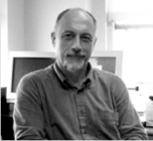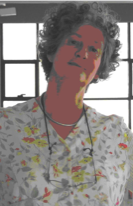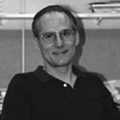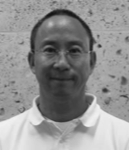Symposium Keynotes
We are pleased to announce the following keynote talks:
Iteration in Design
Ömer Akin
CMU, USA
The Dead Pencil
Gabriela Goldschmidt
Technion, Israel
Design = Calculating
George Stiny
MIT, USA
Entities and Identities
Wilfried Wang
University of Texas at Austin, USA
Iteration: What is it good for?
Speaker
Prof. Ömer Akin, School of Architecture, Carnegie Mellon University, Pittsburgh, USA
Abstract
Iteration has been a key concept, method and theory in many areas of research and practice, including mathematics, computer science, music, language, cognitive psychology, HCI, industrial design, planning, and architectural design.
The phenomenon is ubiquitous in everyday and non-design situations, like speech, song, rehearsal, psychosis, communication, and human settlement. In this keynote I will explore seminal examples of iteration in the design thinking and design cognition literature and present a framework for understanding the basic parameters, role, and potential impact of iteration in design(architectural, software, industrial, shape grammars, and so on). The definition of iteration will be based on the assumption that “progressive refinement” is its principal purpose.
In addition, some speculative questions spun off from this deliberation will be posed; “Is there a logical basis to design?” “Can we do without iteration in design?” “What about the first design is the last design phenomena?” “Are there prerequisites for successful iterative design processes?”
About the Speaker

Ömer Akin has been a faculty member at Carnegie Mellon University since 1977. He earned his Ph.D. from the graduate programs of the Department of Architecture in 1979 and has been conducting research on the design process and architectural ethics since then. He has authored numerous publications on topics including creativity, early stages of design, architectural programming, computer aided design and human computer interaction. He has served as the chair of three international conferences and guest editor of several international journals.
His teaching in the design studio deals with user occupancy and building systems integration; and in the class room with architectural decision making, the design process, and research methods. He has lectured nationally and internationally on related topics. He has been advising graduate students in similar areas of research since the early eighties. He has served in many administrative positions including as head of the School of Architecture. His personal accomplishments include professional recognition and national athletic championships.
His teaching in the design studio deals with user occupancy and building systems integration; and in the class room with architectural decision making, the design process, and research methods. He has lectured nationally and internationally on related topics. He has been advising graduate students in similar areas of research since the early eighties. He has served in many administrative positions including as head of the School of Architecture. His personal accomplishments include professional recognition and national athletic championships.
The Black Curtained Studio: Eulogy to a Dead Pencil
Speaker
Prof. Gabriela Goldschmidt, Professor Emeritus, The Mary Hill Swope Chair in Architecture & Town Planning
Faculty of Architecture and Town Planning, TECHNION - Israel Institute of Technology
Faculty of Architecture and Town Planning, TECHNION - Israel Institute of Technology
Abstract
Architectural education is largely based on the studio experience. The studio is a simulation of practice, to one degree or another; it is where students work on design projects with the guidance of teachers who are, for the most part, practicing architects. We inherited the studio system from the Ecole des Beaux Arts’ atelier where it was initiated two centuries ago, and every architectural education program since then, regardless of philosophy and vision, has left the studio intact.
The most prevalent activity in the studio is the desk crit (critique), in which the student presents a current version of his or her project to the teacher and then they discuss it, with the aim of advancing the project. The discussion is based on the presentation materials which, until recently, consisted mostly of paper drawings and three dimensional models at various levels of articulation and detail. The teacher would bring along a pencil and often speech was accompanied by quick sketches, on the student’s drawings or on overlaid sheets of paper. This was done in order to correct mistakes, clarify issues, give examples from precedents, and suggest different options. The crit would thus be truly interactive.
Today this is no longer the case in many studios. The students do not bring rolls of drawings and sometimes refuse to build cardboard models even when asked to do so. Instead they bring their computers and project onto a screen a PowerPoint presentation of two and three dimensional drawings they had prepared using one or another modeling software. Classrooms are equipped with black curtains which are drawn so that images will be clearer in the dark. Teachers no longer carry pencils; instead they sometimes use laser pointers to single out something on the screen during the discussion. Teachers talk, but they do not demonstrate and do not model for students. We must bear in mind that unlike reviews and formal juries wherein a finished product or a finished phase are presented for discussion, the crit is a much more informal and frequent event that a student experiences two or three times a week; the material presented is work in progress that is subject to continuous revisions.
This is a totally new way of handling the traditional ‘crit’, and we claim that in terms of educational benefits, the death of the pencil in the studio is a great loss. In the dialogue which is the crit, it is the teacher’s role to help the student reach the best results possible, but also ensure that the student will learn from the process lessons that transcend the current project. In the traditional studio the dialogue between teacher and student had two communication channels that reinforced one another – speech and action, the action being acts of drawing; this facilitated the creation of a shared mental model of both the task and the solutions. In the digital studio we limit ourselves to a single channel, that of speech, and often mental models of the two parties are shared only partially, if at all. This talk will compare the two modes of critiquing and show why it is essential to find a way to bring back the action channel to the crit in the architectural studio.
About the Speaker

Gabriela Goldschmidt held the Mary Hill Swope Chair in Architecture & Town Planning at the Technion – Israel Institute of Technology, Faculty of Architecture and Town Planning, until her retirement a few months ago. A graduate of the School of Architecture at Yale University, she had practiced architecture until she became a full-fledged academic in the late 1980s. Based at the Technion, she has also held visiting appointments at MIT, Stanford University, Delft University of Technology, University of Montreal and Bezalel Academy of Art and Design. Her research interests include design cognition, design reasoning, design representation, visual thinking and design education. These topics had informed her writings and the graduate seminars she had taught. Gabriela continues to carry out research work and supervise theses in her areas of interest.
How easy is a bush supposed a bear?
Speaker
Prof. George Stiny, Professor of Design and Computation, Department of Architecture, MIT, USA
Abstract
Alberti puts seeing (observation) first in his account of art and design in the opening lines of De Statua – with a twist, but all seeing is like this:
[Artists] probably occasionally observed in a tree-trunk or clod of earth and other similar inanimate objects certain outlines in which, with slight alterations, something very similar to the real faces of Nature was represented. They began, therefore, by diligently observing and studying such things, to try to see whether they could not add, take away or otherwise supply whatever seemed lacking to effect and complete the true likeness.
Seeing is the crux of art and design – as the way to go on and the puzzle to solve. How is Albertiʼs fantastic way of seeing used, and what makes it tick?
The answers to these questions are in the formula
design = calculating
Shape grammars prove this equality by shifting the basis for calculating from counting to seeing. First, shape grammars enlarge calculating for art and design, so that Albertiʼs way of seeing applies recursively everywhere. Shape grammars include Turing machines as a special case – symbols, identity, and discrete translations in Turing machines become shapes, embedding, and continuous transformations, but embedding is the key. (Ironically, this strikes an arc from pencil drawing to numerical analysis, connecting art and science in a new way – farewell two cultures!) And then, art and design are calculating in shape grammars. They describe real creative work, when whatever anyone sees poses a viable option.
In Shakespeareʼs A Midsummer Nightʼs Dream, Theseus dismisses the tricks of “strong imagination” – its “shaping fantasies” are “more strange than true.”
Such tricks hath strong imagination,
That if it would but apprehend some joy,
It comprehends some bringer of that joy;
Or in the night, imagining some fear,
How easy is a bush supposed a bear!
That if it would but apprehend some joy,
It comprehends some bringer of that joy;
Or in the night, imagining some fear,
How easy is a bush supposed a bear!
Is the bush a bear? Alberti may see it in leaves and branches or in empty spaces to trace its likeness, and if he does, itʼs not a lapse but a creative act both strange and true. Such tricks in shape grammars meld design and calculating in the shaping fantasies of strong imagination – Albertiʼs way of seeing in which embedding changes whatʼs there freely time and again “grows to something of great constancy.”
About the Speaker

George Stiny is Professor of Design and Computation at the Massachusetts Institute of Technology in Cambridge, Massachusetts. He joined the Department of Architecture in 1996 after sixteen years on the faculty of the University of California, Los Angeles, and currently heads the PhD program in Design and Computation at MIT. Educated at MIT and at UCLA, where he received a PhD in Engineering, Stiny has also taught at the University of Sydney, the Royal College of Art (London), and the Open University. His work on shape and shape grammars is widely known for both its theoretical insights linking seeing and calculating, and its striking applications in design practice, education, and scholarship. Stiny has recently completed a book on design and calculating -- Shape: Talking about Seeing and Doing – published by The MIT Press in 2006, and is the author of Pictorial and Formal Aspects of Shape and Shape Grammars (Birkhäuser, 1975), and (with James Gips) of Algorithmic Aesthetics: Computer Models for Criticism and Design in the Arts (University of California Press, 1978).
On the notions of Cognitive Entities and Cognitive Identities in Architecture
Speaker
Wilfried Wang, O'Neil Ford Centennial Professor of Architecture, The University of Texas at Austin
Abstract
How do we know when an architectural design proposal is appropriate and sustainable, both in its socio-cultural as well as performative-technical dimension?
The talk will argue that the notions of cognitive entities and cognitive identities pre-exist and that they are essential to the structuring of any description, analysis, evaluation and criticism of any architectural design proposal.
Cognitive entities are forms and spaces with sufficient degrees of definition distinguishing such formal and spatial elements as figures from their grounds; see Hillier and Hanson's notion of convexity. Convexity is one measure in the difference between a figure and a ground, others being color, materiality, surface texture, etc.
Cognitive entities are objects that are the various elements of building morphology. Second order cognitive entities are morphological categories such as construction, tectonics, compartments, configurations and context.
The talk will present a model for the criticism of architecture and therein embed the notions of cognitive entities and cognitive identities. This model of architectural criticism is part of a theory of architecture.
The notions of cognitive entities and cognitive identities are argued to be important in assisting our ability to know when an architectural design proposal is appropriate and sustainable (preferably before it is built).
About the Speaker

Wilfried Wang is the O'Neil Ford Centennial Professor in Architecture at the University of Texas at Austin. With Barbara Hoidn, he is founder of HOIDN WANG PARTNER, Berlin.
Born in Hamburg, studied architecture in London, founding editor of 9H Magazine; co-director of the 9H Gallery London; from 1995-2000 director of the German Architecture Museum.
Author and editor of various mono- and topographic publications on the architecture of the 20th century. Co-editor of O’Neil Ford Mono- and Duograph series. Chairman of the Board of the Schelling Architecture Foundation; member of the design review board of Munich Airport; honorary member of the BDA; foreign member of the Royal Swedish Academy of Arts; member of the Academy of the Arts Berlin; Dr. h.c. from the Royal Institute of Technology, Stockholm.